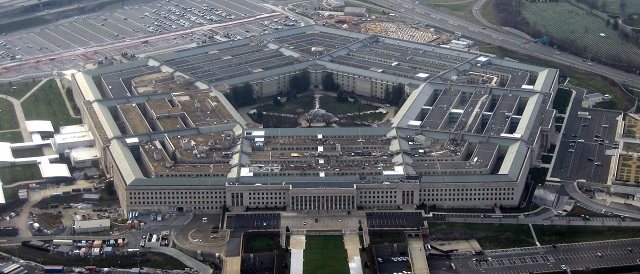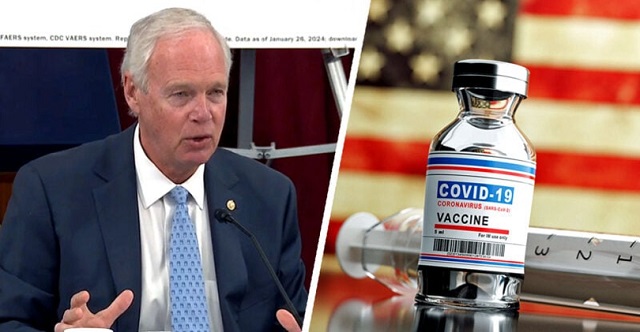COVID-19
‘Incompetence’: Pentagon Doesn’t Know How Much Money It Sent To Chinese Entities For Risky Virus Research

 From the Daily Caller News Foundation
From the Daily Caller News Foundation
By NICK POPE
The Department of Defense (DOD) does not know how much money it directly or indirectly sent to Chinese entities to conduct research on viruses with pandemic potential, according to a new report by the DOD’s Office of Inspector General (OIG).
The OIG’s report found that DOD has supplied Chinese entities — whether directly or indirectly via subgrants — with taxpayer cash to research pathogens and the enhancement thereof, but the exact figure is unknown because of “limitations” in the DOD’s internal tracking system. Government funding for such research in China has come under scrutiny since the coronavirus pandemic, which multiple government entities believe started when an engineered virus leaked from a Chinese laboratory that was hosting U.S. government-backed gain-of-function research.
“Incompetence, absurdity, insanity; it’s hard to find a word that adequately describes this. Of all the things that DOD tracks, funds for dangerous research that could find their way to a hostile regime should be at the top of the list of those they keep close tabs on,” Michael Chamberlain, director of Protect the Public’s Trust, told the Daily Caller News Foundation regarding the OIG report’s findings. “It makes you wonder if they really know where all our nuclear warheads are. The military is one of the few areas of government in which the public still maintains a modicum of trust, but, sadly, it looks like they are working hard to squander even that.”
Due to limitations in the DoD's tracking systems, the full extent of DoD funds provided to Chinese research laboratories for research related to enhancement of pathogens of pandemic potential is unknown. Read our new report now: https://t.co/Ts7V7C15V9
— DoD Office of Inspector General (@DoD_IG) June 20, 2024
The OIG review of this specific issue was required by the terms of the National Defense Authorization Act (NDAA) for fiscal year 2024, which President Joe Biden signed into law in December 2023. The OIG’s investigation sought to determine just how much taxpayer cash was routed via “grants, contracts, subgrants, subcontracts, or any other type of agreement or collaboration, to Chinese research labs or to fund research or experiments in China or other foreign countries that could have reasonably resulted in the enhancement of pathogens of pandemic potential, from 2014 through 2023.”
Specifically, the OIG learned from U.S. Army officials that 12 grant awards fit the description of what it was investigating, seven of which were subgrants or subcontracts provided to entities in China or other foreign countries for research involving or related to enhanced pathogens, its report states. The OIG’s review also identified a further $9.9 million in funding that reached Chinese entities for research purposes, though that research was unrelated to pathogens.
“However, we did encounter significant challenges in searching for awards related to section 252 of the FY 2024 NDAA reporting requirement due to limitations in the DoD’s systems used to track contracts and grants,” the OIG report states. “Therefore, the full extent of DoD funds provided to Chinese research laboratories or other foreign countries for research related to enhancement of pathogens of pandemic potential is unknown.”
The issues with DOD’s grant tracking systems created “significant constraints” for OIG that “hindered [its] ability to conduct a thorough examination” of DOD’s involvement in funding this specific type of research, the report states.
The Government Accountability Office (GAO) previously conducted a similar review of DOD’s spending and Chinese entities receiving taxpayer dollars to conduct research on pathogens of pandemic potential, and its final report — published in September 2022 — also detailed similar struggles with the DoD’s grant and sub-grant tracking systems.
Did NIH fund gain-of-function research in Wuhan?
Dr. Tabak in 2024: "If you're speaking about the generic term, yes we did."
Dr. Fauci in 2021: "The NIH has not ever and does not now fund gain-of-function research in the Wuhan Institute…" pic.twitter.com/VIi0PVhFa6
— Daily Caller (@DailyCaller) May 17, 2024
The Department of Energy (DOE) has concluded that the COVID-19 pandemic most likely began when the virus leaked from the Wuhan Institute of Virology in China, which was the site of gain-of-function research funded by the U.S. government via an organization called EcoHealth Alliance. Additionally, Federal Bureau of Investigation (FBI) Director Christopher Wray has acknowledged that his organization has reached a similar conclusion.
Despite this, former Director of the National Institute of Allergy and Infectious Diseases Anthony Fauci has reiterated his position that a lab leak is the less likely scenario of the two as recently as Tuesday. The COVID-19 pandemic killed more than one million Americans, according to the Centers for Disease Control and Prevention (CDC), and millions more globally, while the American policy response to the pandemic inflicted considerable economic and social damage on the general public.
The DOD did not respond immediately to a request for comment.
COVID-19
Freedom Convoy protester appeals after judge dismissed challenge to frozen bank accounts

From LifeSiteNews
Protestor Evan Blackman’s legal team argues Trudeau’s Emergencies Act-based bank account freezes were punitive state action tied directly to protest participation.
A Freedom Convoy protester whose bank accounts were frozen by the Canadian government says a judge erred after his ruling did not consider the fact that the funds were frozen under the Emergencies Act, as grounds for a stay of proceedings.
In a press release sent out earlier this week, the Justice Centre for Constitutional Freedoms (JCCF) said that Freedom Convoy protestor Evan Blackman will challenge a court ruling in his criminal case via an appeal with the Ontario Superior Court of Justice.
“This case raises serious questions about how peaceful protest is treated in Canada and about the lasting consequences of the federal government’s unlawful use of the Emergencies Act,” noted constitutional lawyer Chris Fleury. “The freezing of protestors’ bank accounts was part of a coordinated effort to suppress dissent, and courts ought to be willing to scrutinize that conduct.”
Blackman was arrested on February 18, 2022, during the police crackdown on Freedom Convoy protests against COVID restrictions, which was authorized by the Emergencies Act (EA). The EA was put in place by former Prime Minister Justin Trudeau’s Liberal government, which claimed the protests were violent, despite no evidence that this was the case.
Blackman’s three bank accounts with TD Bank were frozen due to his participation in the Freedom Convoy, following a directive ordered by Trudeau.
As reported by LifeSiteNews, in November of this year, Blackman was convicted at his retrial even though he had been acquitted at his original trial. In 2023, Blackman’s “mischief” and “obstructing police” charges were dismissed by a judge due to lack of evidence and the “poor memory of a cop regarding key details of the alleged criminal offences.”
His retrial resulted in Blackman getting a conditional discharge along with 12 months’ probation and 122 hours of community service, along with a $200 victim fine surcharge.
After this, Blackman’s application for a stay of proceedings was dismissed by the court. He had hoped to have his stay of proceedings, under section 24(1) of the Charter of Rights and Freedoms, allowed. However, the judge ruled that the freezing of his bank accounts was legally not related to his arrest, and because of this, the stay of proceedings lacked standing.
The JCCF disagreed with this ruling, noting, it “stands in contrast to a Federal Court decision finding that the government’s invocation of the Emergencies Act was unreasonable and violated Canadians’ Charter rights, including those targeted by the financial measures used against Freedom Convoy protestors.”
As of press time, a hearing date has not been scheduled.
In 2024, Federal Court Justice Richard Mosley ruled that Trudeau was “not justified” in invoking the Emergencies Act.
In early 2022, the Freedom Convoy saw thousands of Canadians from coast to coast come to Ottawa to demand an end to COVID mandates in all forms. Despite the peaceful nature of the protest, Trudeau’s federal government enacted the EA in mid-February.
After the protesters were cleared out, which was achieved through the freezing of bank accounts of those involved without a court order as well as the physical removal and arrest of demonstrators, Trudeau revoked the EA on February 23, 2022.
COVID-19
Senator Demands Docs After ‘Blockbuster’ FDA Memo Links Child Deaths To COVID Vaccine


From the Daily Caller News Foundation
By Emily Kopp
The letter, exclusively shared with the Daily Caller News Foundation, seeks more details about those deaths and the passive U.S. vaccine safety surveillance system and complacent Food and Drug Administration (FDA) bureaucracy under the Biden administration that delayed their reporting for years.
“Nobody wanted to admit that these things were causing death. This is absolutely a case of willful ignorance,” Johnson said in an interview with the DCNF.
As a nonprofit, we are dependent on the generosity of our readers.
Please consider making a small donation of any amount here.
Thank you!
The letter requests from the Department of Health and Human Services (HHS) “all records referring or relating to the review of the 96 reports of death following a COVID-19 vaccine … including but not limited to, any memorandum or report created following that review and the data underlying the reports.”
“I am grateful that we now have individuals at our federal health agencies who care about vaccine safety and efficacy. I am, however, disappointed that despite having subpoenaed HHS for the type of data and information described in Dr. Prasad’s memo, it does not appear to have been provided to my office,” the letter reads.
HHS did not immediately respond to a request for comment.
“This is a profound revelation. For the first time, the US FDA will acknowledge that COVID-19 vaccines have killed American children. Healthy young children who faced tremendously low risk of death were coerced, at the behest of the Biden administration, via school and work mandates, to receive a vaccine that could result in death. In many cases, such mandates were harmful. It is difficult to read cases where kids aged 7 to 16 may be dead as a result of covid vaccines,” Prasad wrote. “There is no doubt that without this FDA commissioner [Marty Makary], we would not have performed this investigation and identified this safety concern. This fact also demands serious introspection and reform.”
“One reason I’m writing this letter is that this memo needs much greater attention. This should be a blockbuster,” the Wisconsin senator told the DCNF.
Johnson, who has investigated the issue of COVID vaccine-linked adverse events since June 2021, also seeks more clarity about why FDA only examined a fraction of total reports to the Vaccine Adverse Event Reporting System (VAERS). He noted that the 96 deaths scrutinized by FDA staff in its investigation represents a sliver of the raw VAERS reports of 9,299 deaths worldwide within two days of vaccination.
Distinguishing which VAERS reports indicate genuine fatal side effects and which represent mere coincidences requires autopsy reports, which regulators and physicians often do not request because of a ideological reluctance to acknowledge that vaccines can carry risks, Johnson told the DCNF. Johnson said he has spoken to families who suspected a vaccine injury but struggled to obtain autopsies.
“With some of these officials at federal health agencies and within the medical establishment, vaccines are religion. The do not want to muddy the water with facts,” he said.
Johnson’s letter notes that Prasad acknowledged a culture at FDA “where vaccines are exculpated rather than indicted in cases of ambiguity,” and that the true number of deaths is likely higher.
Johnson has as chair of the Senate Permanent Subcommittee on Investigations investigated the Biden administration’s headlong expansion of COVID vaccines and booster shots to healthy young adults and children.
His committee uncovered internal federal documents showing the Centers for Disease Control and Prevention never updated its vaccine surveillance tool “V-Safe” to include cardiac symptoms, despite naming myocarditis as a potential adverse event by October 2020, per a May report. The investigation also found that top officials at FDA obstructed a warning to pediatricians and other providers about the risk of myocarditis after the May 2021 authorization of the Pfizer vaccine for 12 to 15-year-olds, months after Israeli health officials first detected the safety signal in February 2021.
Johnson’s letter highlights missing safety studies that the drugmakers never conducted.
Under the Biden administration, the FDA waived the responsibility of the drugmakers to conduct post-market studies that they had pledged to regulators, scientific advisors on the FDA Vaccines and Related Products Advisory Committee, and the public that they would complete. These uncompleted studies include promised research into subclinical myocarditis, undocumented rates of heart inflammation without obvious symptoms, Prasad’s memo states.
Johnson’s letter reveals the committee has not received any records from HHS about the liability shield for COVID-19 vaccines.
A public health media personality reported on Dec. 11 that FDA staff had downgraded the certainty with which it can attribute some the deaths to the vaccine in the weeks since Prasad received their top line results — echoing prior leaks from career officials aimed at undermining FDA’s new bosses.
Center for Drug Evaluation and Research Acting Director Tracy Beth Hoeg first concluded in a separate analysis that there were in fact deaths in children in the summer, but career staff leaked the results to reporters who “portrayed the incident as Dr. Hoeg attempting to create a false fear regarding vaccines” soon after, per Prasad’s memo.
Johnson’s letter seeks documentation of Hoeg’s meeting, including “a list of all attendees.”
-

 Automotive3 hours ago
Automotive3 hours agoPoliticians should be honest about environmental pros and cons of electric vehicles
-

 Agriculture2 days ago
Agriculture2 days agoWhy is Canada paying for dairy ‘losses’ during a boom?
-

 Agriculture2 days ago
Agriculture2 days agoCanadians should thank Trump for targeting supply management
-

 Business2 days ago
Business2 days agoCanada Hits the Brakes on Population
-

 Frontier Centre for Public Policy2 days ago
Frontier Centre for Public Policy2 days agoCanada Lets Child-Porn Offenders Off Easy While Targeting Bible Believers
-

 Business2 days ago
Business2 days agoWhite House declares inflation era OVER after shock report
-

 Daily Caller1 day ago
Daily Caller1 day ago‘Almost Sounds Made Up’: Jeffrey Epstein Was Bill Clinton Plus-One At Moroccan King’s Wedding, Per Report
-

 Crime1 day ago
Crime1 day agoBrown University shooter dead of apparent self-inflicted gunshot wound





